| JOURNAL 2015 |
| North Craven Heritage Trust |
Background
A few years ago, I spent time collecting material for a dissertation on all aspects of Celtic spirituality, both pre-Christian and Christian [Kinder, 1999]. This involved my travelling around the UK and Ireland to study Celtic and Northumbrian holy sites. Northumbria was a kingdom which happily married Anglo-Saxon and Celtic influences, and of which North Craven was a part.I became aware, especially in Ireland, of holy wells and the ‘sacred spaces’ created by holy wells and free-standing crosses, all situated around and protecting the central church or chapel. Other Celtic and Northumbrian churches have a free-standing cross (sometimes several, as at Whalley and originally at Ilkley) situated near an entrance, on the south-side of the church. Collingwood in his Northumbrian Crosses of the Pre-Norman Age, calls these ‘rood staff crosses’. North Craven has some of these. They have a tragic history, since most were decapitated by Cromwell’s forces during the seventeenth century. The desecration in North Craven is the worst I have seen in any area of the UK. Apart from a comment in a Kirkby Malham Church guide book that ‘a preaching cross’ probably preceded the church building, there is no reference in any local history publication to the presence and purpose of single, plain, south-side, headless stone shafts in churchyards.
The Christian kingdom of Northumbria was famous throughout western Europe for its remarkable civilisation. It came into being around 627, (the baptism of King Edwin) and lasted until around 866 when, according to The Anglo-Saxon Chronicle, the Danes attacked York killing its residents and destroying churches, monasteries and the city’s great library. Vikings had ransacked Lindisfarne in 793, but it was the burning of York in 866 (or 867 according to some authorities), that truly marked the demise of the Northumbrian kingdom. From York, the Danes moved north and west throughout the Vale of York. They did not venture far into the western dales, but they did go over to the north-west and sack Carlisle. This is the period of history to which current sources say Giggleswick’s patronal saint Alkelda belonged.
St Alkelda re-visited
There is a common view that St Alkelda was probably a ninth- or tenth-century local saint, a nun or abbess, who was strangled for her faith by pre-Christian Danish women. James Carr, founder of Giggleswick School, wrote in his will (1528) that he wanted to be buried in the ‘churche at Gigilswicke of the holie and blissed Virgine Sancte Alkild’. The description of Alkelda as ‘blissed’ (blessed) in this quotation from Brayshaw and Robinson’s The History of the Ancient Parish of Giggleswick gives us an indication that James Carr at least considered her a martyr.There are depictions of St Alkelda’s martyrdom on stained glass windows in both the Giggleswick and Middleham Churches, the only churches dedicated to St Alkelda. The date of c.800 usually given of St Alkelda’s death as in The Oxford Dictionary of Saints appears to be incorrect. There were no Danes in her home district in or around Middleham before 866. Alkelda has come down to us as a saint famous only in her localities of Giggleswick and Middleham, and she did not seem to be of royal birth like Hilda, Ebba and Etheldreda of the seventh or eighth centuries, when only women of royal birth became abbesses. Bede tells us in his History of the English Church and People, that (in the seventh century) there were very few monasteries or convents for women to enter or rule, and that Eargotta, daughter of Eadbald, king of Kent, had to emigrate to find a Frankish (French) monastery in which to serve. Christopher Norton of the Centre for Medieval Studies at York University kindly checked for me the list of Northumbrian saints in the medieval chronicle of John of Tynemouth and there is no mention of St Alkelda. Most minor Celtic saints were not canonized and the prefix ‘St’ was added to their names by the people who valued their ministry in the village or at a well; St Alkelda’s saintly status was entirely local. To add support to a ninth- or tenth-century date, we were told by members of St Mary and St Alkelda’s Church in Middleham during a Giggleswick Church visit there in 2005, of the late nineteenth-century discovery of the bones of a woman under an ancient, unmarked grave in the sanctuary. Who else but St Alkelda ?
Dr Heather Edwards [2004] has discussed St Alkelda at length in her article The saint of Middleham and Giggleswick, but without reference to Brayshaw and Robinson’s The History of the Ancient Parish of Giggleswick. She proposes that her name was Alchhild who was an Anglo-Saxon in the seventh century and that she was not killed by Danes. Slater [2008] discusses the use of the Norse word keld (spring) in an Icelandic place name. Alkelda is a composite Anglo-Saxon - Norse name. It could well be a corruption of haeligkeld, since holy (haelig) well or spring (keld) is often written as hallikeld. This is used in two place names in the Vale of York, not far from Alkelda’s home in Middleham. We have Hallikeld Springs at Melmerby and Halley Keld at Sawdon. Moreover, hallikeld was the name of a Yorkshire wapentake, an Old English and Norse word for a territorial division of land, presumably marked by a holy well.
The word haeligkeld could not enter the vocabulary until Norse settlers came from Ireland during the tenth century and colonised the western dales. As Alan King points out in his book Early Pennine Settlement the greatest Norse influence was in Lonsdale and Kentdale and it continued eastward into the Yorkshire Dales.There is however, the possibility that keld was a word known and used by the Danes, and that could give a late ninth century origin for the word haeligkeld. Another possibility is that the name Alkeld first appeared in Giggleswick, if keld was exclusively Norse. Of course, we will probably never know the real name of our patronal saint. The name Athilda is given as an alternative to Alkelda in The Oxford Dictionary of Saints, but Athilda never occurs in the medieval records.
Dr Edwards’ view that St Alkelda was probably called Alchhild would only be reasonable if Alkelda was a seventh- or eighth-century Anglo-Saxon saint of noble birth. The historical evidence provided by medieval records and by Bede, and Dr Edwards’ arguments for a seventh- or eighth-century date do not fit together. Although it may have been a little time after her death when she acquired her name, there is no evidence from traditional sources that Alkelda was not called Alkild (James Carr’s will of 1528) or Awkeld, as the Giggleswick holy well was addressed in the 1602 parish Bylaws (see The History of the Ancient Parish of Giggleswick.) Challoner [1761] refers to ‘St Athilda or Alkilda’. One should remember that, as Chaucer put it:
‘And for ther is so gret diversite
In Englissh and the writynge of oure tongue ...’
The spelling Awkeld is how ordinary village folk would have pronounced the name.
There is no evidence for Dr Edwards’ suggestion that Giggleswick Church was a daughter church of Middleham, although in the Middle Ages there must have been considerable traffic between Middleham and Giggleswick via Coverdale, Kettlewell, Mastiles Lane, Malham and Stockdale. We know from Ripon records that during the early Middle Ages, the Cathedral had lands in Ribblesdale, (given first to St Wilfrid) and that later Jervaulx Abbey held land at Horton. Middleham lies on a major trackway from Ripon and Jervaulx and is situated at the entrance to Coverdale.
Dr Edwards’ work has, however, increased the probability that Alkelda was truly a historical person. Her research shows that the first historical reference to Alkild in Middleham was in 1389 in a grant from Richard II for the people of Middleham to hold a Fair on St Alkild’s feast day. That annual event was finally discontinued in 1926. The next reference was in 1480 when the Duke of Gloucester (Richard III), lord of the manor of Middleham, established the collegiate church of St Mary and St Alkild. Alkild’s tomb was reputedly still in the church in 1553, while a piece of her head was amongst the bequests of the Dean of Middleham in 1559.
Why does Giggleswick Church have such a late dedication to St Alkelda and why was 1389 the first mention of St Alkelda in Middleham? The Black Death in the fourteenth and the Wars of the Roses in the fifteenth centuries resulted in an increase in the veneration of the Virgin Mary and saints, in response possibly to the anxiety and insecurity of the times. Moreover, the Scots burnt down Giggleswick Church in 1319 and the church was left in a derelict state for a considerable period. Giggleswick Church had no patronal saint until well after it was repaired and rebuilt at the end of the fifteenth century. Some ancient churches have changed their patronal saints several times; St Mary’s, Thornton in Craven, is one, and some, like Beverley Minster and Bridlington Priory, have no dedication at all.
Giggleswick's Holy Wells
A most memorable visit was to the exquisite tiny chapel on the shoreline at Llandrillo yn Rhos, where the fresh waters of the holy well flow under the altar and out to sea. Both the church and the holy well are dedicated to the Welsh Celtic saint St Trillo and that since the holy well, as holy springs are always called, was obviously there long before the church, it was the holy well that had given its name to the church. According to The Oxford Dictionary of Saints, there is no record of this saint. We only know of him through the place name.St Madron’s Well lies besides St Madron’s ruined chapel north of Penzance in Cornwall. Madron was also known as Madern. This is a ‘cloutie’ or ‘rag’ well, where people hang prayer rags on the trees surrounding the well to ask for healing and answers to prayer. Other similar wells are found near Inverness and Cranfield Church, near Loch Neagh in Northern Ireland. A recent visit to St Helen’s Well at Eshton, near Gargrave, confirmed that it too is a ‘cloutie’ well [Kaneps, 2011]. This pre-Christian to Christian custom of leaving prayer rags has continued right up to the present day. The tiny Celtic well chapels in Cornwall were not for congregational use, but were prayer cells and dwellings for the holy man or woman who looked after the well. Preaching was done beside the well and baptism within its waters. As for holy wells giving their names to churches, there is a good example nearer home. York Minster is built over two holy wells. One of them, dedicated to St Peter, is the well in which the Northumbrian king Edwin was baptised in 627, and St Peter is also the patronal saint of the Minster.
The Christian Celts and Northumbrians viewed holy wells as sacred in a landscape dedicated by them to the Triune God (the Trinity). The vast majority of holy wells associated with a Christian saint were previously dedicated to a pre-Christian deity. The Celts were masters at baptising what was pre-Christian ‘into Christ’ and often changed the name of a well from a pre-christian god/goddess to a Christian saint. Water is essential for life and springs that flowed continuously and mysteriously from underground must have been objects of awe and wonder. Consider too how people must have reacted when they saw the Giggleswick Ebbing and Flowing Well’s waters rising and falling. The left section of the 1903 west window in Giggleswick Church depicts the Ebbing and Flowing Well as an equivalent Pool of Bethsaida with two children waiting to step in and be healed while an angel stirs the waters. Was the Ebbing and Flowing Well regarded as a holy well? Thomas Brayshaw recorded various beliefs about the supposed supernatural nature of the well in The History of the Ancient Parish of Giggleswick and in his Local Tract: ‘Collectanea Giggleswickiana Part 1,’ 1886 . A large extract of that is printed in Bits , Pieces & All Sorts from Giggleswick and Beyond, compiled by Callan, Fox and Kinder [2004].
Giggleswick had three wells or springs. Apart from the Ebbing and Flowing Well, there is St Alkelda’s Well and Bank Well, near the vicarage, which never dries up. We know Bank Well was venerated in pre-Roman Celtic times because of the female lead figurine found in its depths. This (from the photograph in Alan King’s Early Pennine Settlement) looks very much like a votive offering to the female deity of the well. There is a 1564 Giggleswick Bylaw (see The History of the Ancient Parish of Giggleswick) which requires the villagers to keep Bank Well clean. The Bylaw of 1602 exhorts the villagers not to leave any meat, fish or any other ‘hurtful thing’ to ‘steep’ in the waters of St Awkeld’s Well. Is this just a general health warning or does the practice refer to votive offerings?
Until 1850, St Alkelda’s Well was marked on Ordinance Survey maps of the area. The well was located on Holywell Toft (hill) near Giggleswick School’s main drive. Its waters were put underground during the School’s building programme of 1850. The headmaster’s house is called Holywell Toft and is built over the well itself. Its waters now emerge from the conduit as part of Tems Beck and flow alongside Giggleswick’s Main Street. Reading from a large scale local map, it seems that the three wells form a triangular ‘Sacred Space’ around Giggleswick Church. According to Philip Sheldrake’s Living between Worlds - place and journey in Celtic spirituality, there are many churches in England built beside a sacred well or spring whose saint’s name they have appropriated. There are at least 67 churches with wells in the Gazetteer in Nigel Pennick’s book Celtic Sacred Landscapes. Some of these have the same saint’s name for well and church.
A visit recently to St Helen’s Church, Waddington, provided me with more support for the view that a holy well can give its name to a church. St Helen’s was built in 1500, as a daughter church of All Hallows, Mitton, near a holy well and what appear to have been originally two Northumbrian crosses. St Helen is the Christian saint, mother of Constantine, but Elen or Ellen was a three-headed pre-Christian Celtic goddess associated with wells. There are in England, especially in Yorkshire and Humberside, a large number of churches with wells dedicated to St Helen. It seems most likely that Giggleswick Church got its dedication from its ancient holy well. The re-ordering of the church in 1892 revealed traces of an Anglian Christian worship site, probably based round St Alkelda’s holy well and the wooden rood staff left by a Northumbrian missionary. Its successor in stone is still standing in the church yard today. St Alkelda’s holy well in Middleham (in a state of serious neglect) would perform a similar function for the church of St Mary and St Alkelda nearby.
South-side Crosses
In Northern England, Cornwall, Scotland, Ireland and Wales there are crosses within the consecrated ground of the church yard. The position of the crosses (and in some cases, holy wells too) in relation to the churches is of significance. Many Celtic and Anglian church yard crosses occur on the south side of the church, usually near a south door. In Ireland, at Monasterboice, four great Celtic crosses surround the ancient church ruin. Castledermot has three, Clonmanoise and Kells at least four. Durrow has one famous cross beside a holy well and so does Moon. Giggleswick Church is placed between three wells and has a cross shaft by its small south door (not mentioned in any publication on the church). J. Romilly Allen, in The High Crosses of Ireland, describes free-standing crosses as ‘terminal’, that is, they are boundary markers. Where there was one by or over the south door, it guarded the entrance and prevented evil influences from entering and destroying the holy atmosphere of the consecrated area inside.There are hints in ancient records as to how these crosses came about. Jocelinus, a monk of Furness, recalls in his Life of Kentigern how the saint when evangelising in Crosthwaite, Cumbria, first set up a cross where there was none before. Bede tells us that before King Oswald fought against a pre-Christian army at a place in Northumbria called Heavenfield, Oswald set up a wooden cross in the ground before which his army prayed. The cross remained where it had been planted. After the battle, the monks of Hexham Abbey built a church near the cross. Elsewhere, early Northumbrian missionaries came with their wooden rood (cross) staffs and planted them in the ground as they preached to the people. After their departure, the place would be venerated and a wooden church would be built, leaving the cross on the south sunny side. Eventually a stone cross and church would take the place of the original wooden ones. This seems to affirm what had happened at Kirkby Malham, and no doubt elsewhere too.
When the Danes attacked York in 866 or 867, Wulfhere, the Archbishop of York, sought refuge in Addingham. On the website for St Peter’s Church, Addingham, we read: ‘Although the church was of people, and not a building, worship took place around a carved stone cross. The remains of Addingham cross were discovered in 1947.’ A cross head was discovered in the graveyard in Long Preston by a grave digger in 1893. It was found to fit the socket over the porch, and there it can be seen today.
In Cumbria are single, south-side engraved crosses at Bewcastle (decapitated), Gosforth and Irton. A few miles north of the Anglian-Celtic cross in Irton church yard is the magnificent and complete Scandinavian-Celtic cross at Gosforth. As well as in Giggleswick church yard, I have found cross shafts at Kirkby Malham, Mitton, Waddington, Whalley (three with mutilated cross heads, one complete), Ilkley (three, outside, until they were moved inside the church), Slaidburn, (west side), and Gisburn. Cross shafts, adapted into sundials on columns in the seventeenth or eighteenth centuries, are in Long Preston, Waddington, Bolton by Bowland, Slaidburn and Addingham church yards. The Bolton-by-Bowland and Slaidburn sundials are missing, the latter stolen in 1995. The sundial columns in both Slaidburn and Bolton by Bowland church yards are almost identical. Were they the work of the same stone mason? It is the stepped bases of these sundial columns which give clear evidence of their origin as free-standing crosses.
Elsewhere, Gargrave, Kildwick, Burnsall, and Otley churches have preserved fragments of crosses that once stood in their church yards. The old steps by a south entrance to Clapham church’s graveyard look as if they once were the mount of a cross. On the Kirkby Malham, Waddington, Slaidburn and Giggleswick cross shafts, one can make out from the four hollows at the top how the cross head was fastened to the shaft. Head and shaft were fastened together by means of four tenons (prongs) from the head slotting into lead casings of the mortices (holes) in the shaft. Kirkby Malham has the best example locally, but the top of the second cross shaft in Waddington church yard still has the lead casings in place.
Early churchyard crosses in Craven suffered from the iconoclasm of the Commonwealth period. For many people in the past, crosses were not just venerated as worship aids. When the crosses became objects of worship themselves, they then held a certain virtue all of their own. In his twelfth-century Life of St Kentigern, Jocelinus describes how people ‘gave glory to God’ when a huge new cross was erected in their village. This probably relates more to the twelfth century rather than the sixth when Kentigern lived, as the sixth century was too early for free-standing, stone crosses:-
‘For the cross was very large, and never from that time lacked great virtue, seeing that many maniacs and those vexed with unclean spirits are used to be tied of a Sunday night to that cross, and in the morning they are found restored, freed, and cleansed, though oft times they are found dead or at the point of death’.The Roundhead soldiers believed they were eradicating idolatry by smashing stained glass windows and decapitating crosses, so destroying their sacred status. Major General John Lambert of Calton is blamed for ordering the desecration and destruction of church artefacts in much of northern England. We know that he and his troops were billeted for a time in Giggleswick Church. Stained glass was recorded in the church in 1627, but it was not there after the Restoration. John Lambert is remembered in York as the Roundhead general who threatened to smash the Five Sisters Window in York Minster. He was stopped by his superior, General Fairfax. When the monarchy was restored under Charles II, he was condemned to spend the rest of his life in prison. There is a warm and generous memorial to him in his home church at Kirkby Malham. Lambert was a brilliant general, a man with many good qualities, but yet a fanatical Puritan whose own life ended in tragedy.
St Alkelda, her holy well and the south-side cross shafts in church yards, have a great deal to reveal about the early Northumbrian Christian presence in North Craven. There is, however, a hint of an earlier Christianity in Eddius Stephanus’ Life of Bishop Wilfrid, written soon after the death of Wilfrid in 709. There is mention of lands around the Ribble and Dent gifted to Wilfrid by British (Celtic) clergy as tokens of acceptance of the Roman Christianity for which Wilfrid fought so hard at the Synod of Whitby in 664, a tradition which became the hallmark of Northumbrian Christianity. This must have been well established in North Craven by the end of the seventh century when holy wells had acquired a Christian saint’s name, and simple church buildings rose behind the rood staff crosses, all sacred landmarks within a consecrated landscape.
Bibliography and References
- Allen, Romilly J., 1992. Facsimile reprint The High Crosses of Ireland (1887), Llanerch Enterprises
- Bede, 1968. A history of the English Church and People, Penguin Classics
- Brayshaw, T ., 1886. Local Tract 'Collectanea Giggleswickiana Part 1'
- Brayshaw, T. and Robinson R., 1932. The History of the Ancient Parish of Giggleswick, Halton & Co.
- Callan, R., Fox, D., & Kinder, K., (compilers) 2004. Bits , Pieces & All Sorts from Giggleswick and Beyond , edited N. Mussett , Kirkdale Publications, (available from Giggleswick Church)
- Carr, James, 1528. Will at Borthwick Inst., vol. 9 fol. 404 mf 918
- Collingwood W.G, 1989. Northumbrian Crosses of the Pre-Norman Age, Llanerch Enterprises, reprint *
- Edwards, H., 2004. Yorkshire Archaeological Journal, vol. 76, pp135-144
- Farmer, D., 1997. The Oxford Dictionary of Saints, OUP
- Kaneps, D., 2011. North Craven Heritage Trust J., p21
- Kinder, K., 1999. Dissertation for AdipR: Celtic Spirituality: its Application to the Reader Ministry **
- King, A., 1970. Early Pennine Settlement, Dalesman
- Jocelinus of Furness, 1989. The Life Kentigern, (with The Life of Ninian), Llanerch Enterprises
- Lang, J., 1988. Anglo-Saxon Sculpture, Shire Archaeology
- Pennick, N., 1996. Celtic Sacred Landscapes, Thames and Hudson
- Savage, A., (translator and collator), 1982. The Anglo-Saxon Chronicle, Papermac
- Sheldrake, P., 1995. Living between Worlds: Place and Journey in Celtic Spirituality, Darton, Longman and Todd
- Slater, M. J., 2008. North Craven Heritage Trust J., p6
- Stephanus, Eddius Life of Wilfrid, in Webb, J., 1988. The Age of Bede, Penguin Classics
* Llanerch Enterprises specialise in facsimile reprints of early Lives of the Saints:
Web site: www.llanerchpress.com
** A copy for study is available at the Bradford Diocesan Resources Centre, Kadugli House, Elmsley St., Steeton, Keighley BD20 6SE, tel: 01535 650555
Texts available on-line
- Challoner, R., 1761. Memorials of Ancient British Piety,http://books.google.co.uk
- Green, C.W. Life of Kentigern (Mungo), 1998http://www.fordham.edu/halsall/basis/Jocelyn-LifeofKentigern.asp
- Ingram, J. (1823 translation) The Anglo Saxon Chroniclehttp://www.britannia.com/history/docs/asintro2.html
- John of Tynemouth , Nova Legenda Anglie (in Latin)http://www.britannia.com/history/docs/asintro2.html
- John of Tynemouth , Nova Legenda Anglie (in Latin)https://archive.org/details/novalegendaangl00tynegoog
- Middleham Church and St Alkeldahttp://www.jervaulxchurches.co.uk/middleham/
- Moorby. R.C., History of Long Preston,http://www.longpreston.info/history/history.html
- Oxford Dictionary of Saints 2011http://www.oxfordreference.com/view/10.1093/acref/9780199596607.001.0001/acref-9780199596607
- St Alkelda's Well, Middlehamhttp://www.halikeld.f9.co.uk/holywells/north/alkeld1.htm
- St Helen's Well, Eshton, Gargrave p.184ff Dr Whitaker's History & Antiquities of the Deanery of Craven, (1812)https://play.google.com/books/reader2?id=-FdJAAAAcAAJ&printsec=frontcover&output=reader&hl=en_GB&pg=GBS.PA184
- St Peter's Church, Addinghamhttp://www.stpetersaddingham.org.uk/st-peters-church-history/st-peters-9th-century/
- Stephanus, Eddius, Life of Bishop Wilfrid 2010http://ebooks.cambridge.org/ebook.jsf?bid=CBO9780511552946
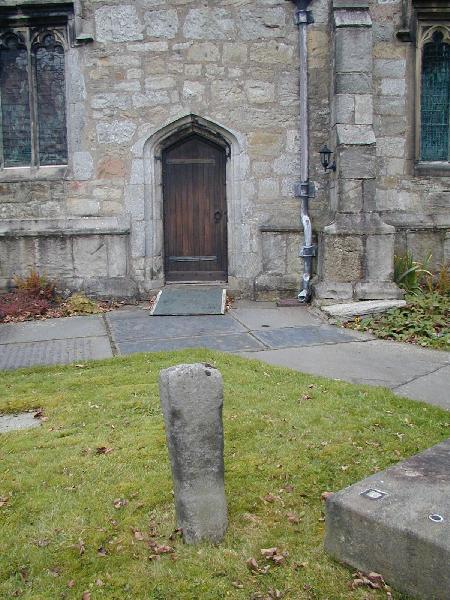
Giggleswick Churchyard Cross Shaft
Mutilated Cross - Whalley
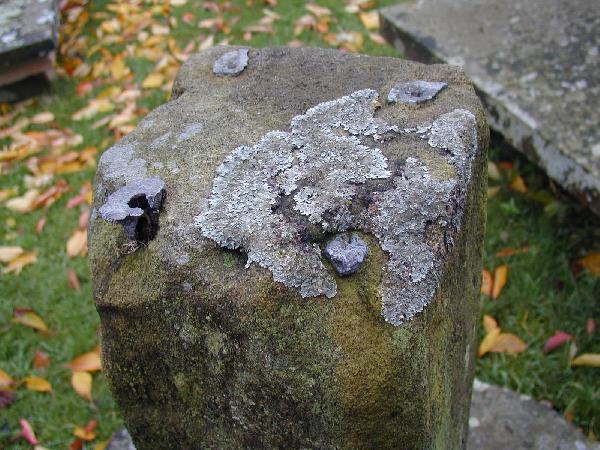
Top of Kirkby Malham Cross Shaft
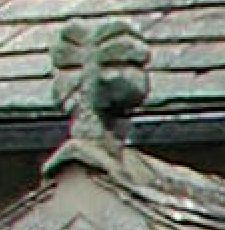
Long Preston Cross Head
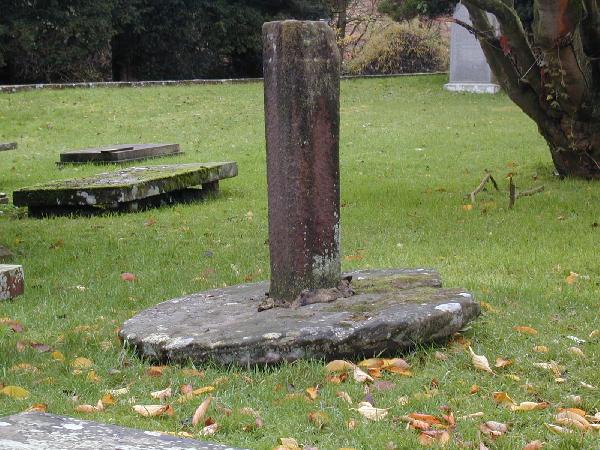
Kirkby Malham Cross Shaft
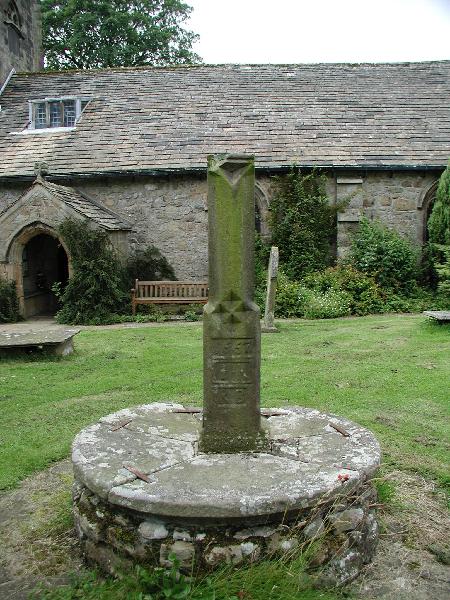
Long Preston Sundial Cross Shaft